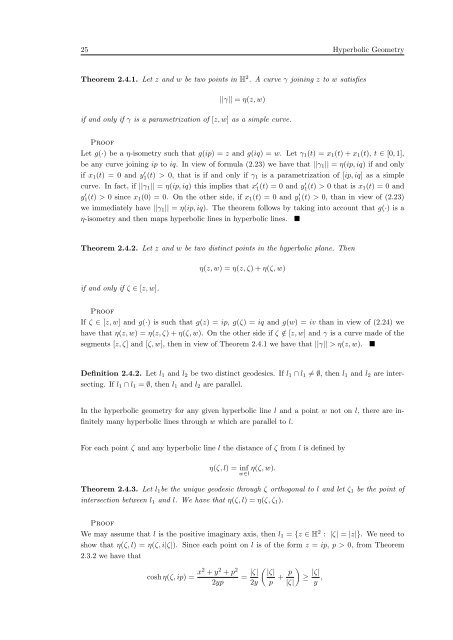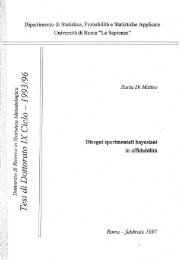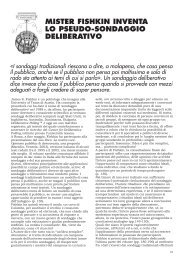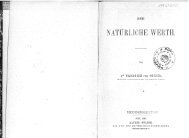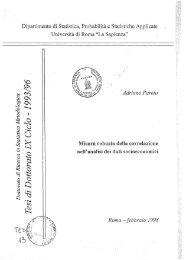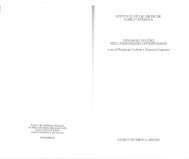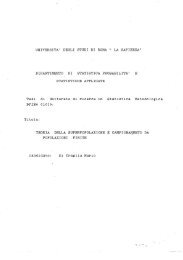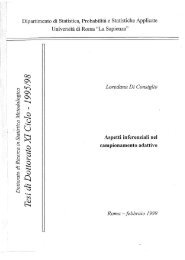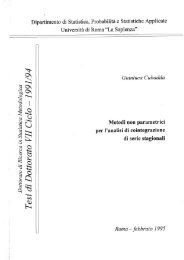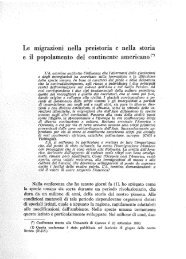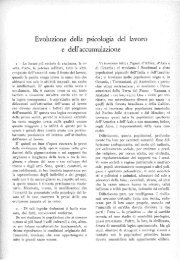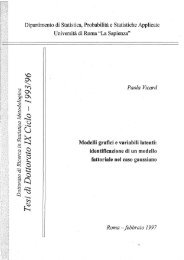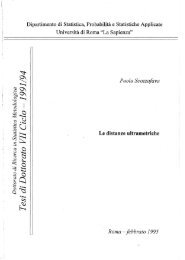Random Processes in Hyperbolic Spaces Hyperbolic Brownian ...
Random Processes in Hyperbolic Spaces Hyperbolic Brownian ...
Random Processes in Hyperbolic Spaces Hyperbolic Brownian ...
You also want an ePaper? Increase the reach of your titles
YUMPU automatically turns print PDFs into web optimized ePapers that Google loves.
25 <strong>Hyperbolic</strong> Geometry<br />
Theorem 2.4.1. Let z and w be two po<strong>in</strong>ts <strong>in</strong> H 2 . A curve γ jo<strong>in</strong><strong>in</strong>g z to w satisfies<br />
||γ|| = η(z, w)<br />
if and only if γ is a parametrization of [z, w] as a simple curve.<br />
Proof<br />
Let g(·) be a η-isometry such that g(ip) = z and g(iq) = w. Let γ1(t) = x1(t) + x1(t), t ∈ [0, 1],<br />
be any curve jo<strong>in</strong><strong>in</strong>g ip to iq. In view of formula (2.23) we have that ||γ1|| = η(ip, iq) if and only<br />
if x1(t) = 0 and y ′ 1(t) > 0, that is if and only if γ1 is a parametrization of [ip, iq] as a simple<br />
curve. In fact, if ||γ1|| = η(ip, iq) this implies that x ′ 1(t) = 0 and y ′ 1(t) > 0 that is x1(t) = 0 and<br />
y ′ 1(t) > 0 s<strong>in</strong>ce x1(0) = 0. On the other side, if x1(t) = 0 and y ′ 1(t) > 0, than <strong>in</strong> view of (2.23)<br />
we immediately have ||γ1|| = η(ip, iq). The theorem follows by tak<strong>in</strong>g <strong>in</strong>to account that g(·) is a<br />
η-isometry and then maps hyperbolic l<strong>in</strong>es <strong>in</strong> hyperbolic l<strong>in</strong>es. <br />
Theorem 2.4.2. Let z and w be two dist<strong>in</strong>ct po<strong>in</strong>ts <strong>in</strong> the hyperbolic plane. Then<br />
if and only if ζ ∈ [z, w].<br />
η(z, w) = η(z, ζ) + η(ζ, w)<br />
Proof<br />
If ζ ∈ [z, w] and g(·) is such that g(z) = ip, g(ζ) = iq and g(w) = iv than <strong>in</strong> view of (2.24) we<br />
have that η(z, w) = η(z, ζ) + η(ζ, w). On the other side if ζ /∈ [z, w] and γ is a curve made of the<br />
segments [z, ζ] and [ζ, w], then <strong>in</strong> view of Theorem 2.4.1 we have that ||γ|| > η(z, w). <br />
Def<strong>in</strong>ition 2.4.2. Let l1 and l2 be two dist<strong>in</strong>ct geodesics. If l1 ∩ l1 = ∅, then l1 and l2 are <strong>in</strong>tersect<strong>in</strong>g.<br />
If l1 ∩ l1 = ∅, then l1 and l2 are parallel.<br />
In the hyperbolic geometry for any given hyperbolic l<strong>in</strong>e l and a po<strong>in</strong>t w not on l, there are <strong>in</strong>f<strong>in</strong>itely<br />
many hyperbolic l<strong>in</strong>es through w which are parallel to l.<br />
For each po<strong>in</strong>t ζ and any hyperbolic l<strong>in</strong>e l the distance of ζ from l is def<strong>in</strong>ed by<br />
η(ζ, l) = <strong>in</strong>f η(ζ, w).<br />
w∈l<br />
Theorem 2.4.3. Let l1be the unique geodesic through ζ orthogonal to l and let ζ1 be the po<strong>in</strong>t of<br />
<strong>in</strong>tersection between l1 and l. We have that η(ζ, l) = η(ζ, ζ1).<br />
Proof<br />
We may assume that l is the positive imag<strong>in</strong>ary axis, then l1 = {z ∈ H2 : |ζ| = |z|}. We need to<br />
show that η(ζ, l) = η(ζ, i|ζ|). S<strong>in</strong>ce each po<strong>in</strong>t on l is of the form z = ip, p > 0, from Theorem<br />
2.3.2 we have that<br />
cosh η(ζ, ip) = x2 + y2 + p2 =<br />
2yp<br />
|ζ|<br />
<br />
|ζ| p<br />
+ ≥<br />
2y p |ζ|<br />
|ζ|<br />
y ,


